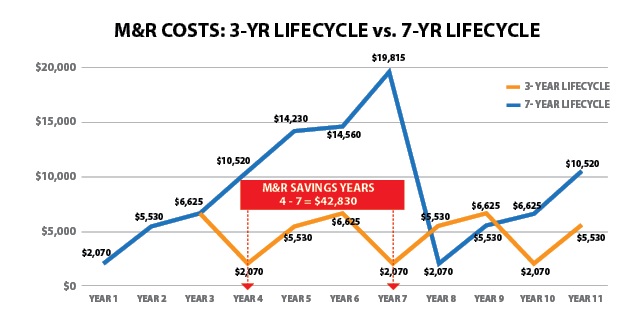With the high costs of maintaining a heavy duty truck it may be more economical to get rid of trucks before they wear out.
Want to save money on maintenance? Get rid of your trucks before they start costing you big bucks. A recently published white paper from Fleet Advantage suggests the longer you keep a truck, the more it costs in maintenance and repairs.
The whitepaper, “Mitigating Rising Maintenance & Repair Costs for Class-8 Truck Fleets: Effective data & strategies to leverage newer trucks to reduce M&R costs,” uses data culled from 5 billion miles of real-world fleet operations, including food service, grocery distribution and chemical tank. When you look at typical maintenance costs over a vehicle’s lifecycle in the accompanying graph, the first three years are fairly flat, but there’s quite a jump between years three and four and between years four and five. It levels out in year six, and then takes another jump in the seventh year.
According to Fleet Advantage, fleets adopting a three-year lifecycle, replacing with new equipment in year four, could see savings of $42,830 in maintenance and repair costs alone, compared to a fleet driving the same truck for a full seven years. Switching from a five-year to a three-year lifecycle would produce savings of $17,150.
“On a new tractor, there’s minimal maintenance expense – tires and PM, mostly – but a few corrective maintenance items are included, and that tends to vary with the make and model of the tractor,” says Matt Hendrix, director of fleet services at Fleet Advantage. “Based on the data we collected, we believe it’s beneficial to trade the asset some time in its third year of life, before the big costs appear. Starting with a new truck at that point keeps the maintenance costs as low as possible.”
Cost aside, the increased maintenance requirements of older equipment also put a strain on shop resources. Service bays and mechanics are tied up longer dealing with older equipment, and equipment is down longer, and ultimately less productive. On average, Hendrix says, a tractor requires 2.5 hours a month to maintain in its first year, but 4.5 hours in year three, nearly doubling the demand while the available resources remain the same.
“This will become an important consideration in the future with the shortage of qualified technicians and shop managers,” he warns. “It follows that as repairs costs go up, so too will labor costs, which is a proxy for labor hours. If you’re short of qualified technicians, how will you be able to keep up with the needed repair on the truck in the later years of its life?”
While some may take issue with the figures Fleet Advantage uses in the white paper, the upward trend in cost with age is undeniable. Fleets today have the advantage of data-driven analytics to see exactly what a vehicle costs to maintain in their own operation, and thus make better decisions about when a truck might become economically obsolete.
The whitepaper is available on request from Fleet Advantage, or it can be downloaded here.
by Jim Park
Source: https://www.worktruckonline.com
CUT COTS OF THE FLEET WITH OUR AUDIT PROGRAM
The audit is a key tool to know the overall status and provide the analysis, the assessment, the advice, the suggestions and the actions to take in order to cut costs and increase the efficiency and efficacy of the fleet. We propose the following fleet management audit.




